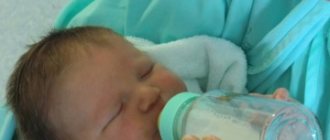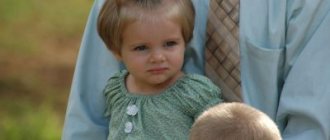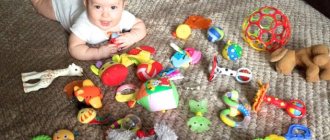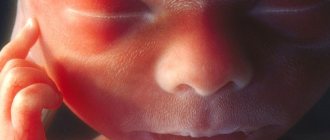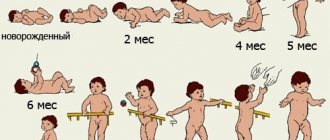nata_tursha
all posts by the author The formation of the human brain occurs in the mother’s belly. And brain development after birth is facilitated by the emergence of new neural connections. And visual perception is of great importance in this important process.
A person receives more than 80% of information from the surrounding world through vision. Therefore, for the full and harmonious development of a small child, it is necessary to stimulate his visual perception. The younger the child, the more intensively he learns. From birth, children need new experiences and food for brain development. If the brain processes only sound stimuli, it does not work at full capacity, which means that it is very important to provide the child with the opportunity to see different objects as early as possible. A child's vision develops gradually. Until two or three months he does not distinguish colors. For this age, clear, contrasting black and white pictures are best suited, which are installed at a distance of 20-30 cm from the child’s eyes. You can use them as long as the child likes them and arouses his interest. Sarah Brewer's book Super Baby describes the role of black and white images in the development of children aged 0 to 3 months.
Excerpts from the book "Super Baby" by Sarah Brewer
Vision plays a decisive role in the development of a child. Seeing various objects in front of him, the child wants to find out what they are. The desire to reach for objects, crawl, and roll over comes from natural curiosity and the desire to explore everything that the child sees around him. In the first two months of his life, he sees best at close range. A newborn baby's field of vision is more limited than an adult's. Presumably, the child’s field of vision includes objects that are no further than 30 degrees to the left and right of him, 10 degrees above and below and at a distance not exceeding 90 cm from his eyes. When he suckles, he naturally focuses his vision on objects located at a distance of 15 - 20 cm. Usually by two weeks the child begins to recognize the faces of his mother and father. His visual acuity is 10 to 30 percent less than that of an adult, so it is more difficult for him to recognize fine lines, which he sees as a blurry gray mass. The retina of the human eye contains photoreceptors such as rods and cones. Rods are cells that are sensitive to low light and movement and can only distinguish shades of black and white. Cones are cells that are responsible for daytime vision and allow you to see different colors and shades. Newborn babies enjoy contrasting black and white pictures more than color ones because at this age their rods work better than their cones. All other colors are seen by them as shades of gray. Since black and white colors are most easily recognized by children, the use of black and white pictures stimulates the formation of connections between neurons in the cerebral cortex, develops attention, stimulates natural childish curiosity and calms down during periods of overstimulation. Also, newborns prefer straight or broken lines rather than curved or wavy ones. In addition, they are attracted to simple, schematic images of human faces. By the sixth week, the baby can clearly focus his vision on different objects at a distance of about 30 cm from him. He is especially attracted to simple images of faces and concentric circles in different variations. The child studies the outer edges of the drawings more closely than their middle. The human brain is fully formed during intrauterine development. The number of neurons does not increase after birth; the brain develops due to the formation of new connections between neurons. The number of contacts between neurons in the area of the cerebral cortex responsible for visual information begins to gradually increase in the first 2 months after birth. Between 2 and 4 months, the number of connections between neurons begins to grow sharply and increases by no less than 10 times. At this time, the child’s vision improves sharply, he can follow objects with his eyes and turn in the direction where the sound comes from. He begins to like more complex designs, rounded lines and shapes, rather than straight and broken ones. From the child’s behavior you can see that he remembers what he saw. Many children begin to distinguish colors by two months because the cones in the retina begin to work. But until three months of age, they presumably don't see blue as well as yellow or red. By four months, the child distinguishes all colors and can focus his vision on both near and distant objects. He enjoys watching parents and other people, especially children. He still prefers curved lines to straight lines and pays attention to more complex designs. At 4 - 5 months, the child begins to reach for objects that he sees; at 7 - 8 months, he can grab objects and try to put them in his mouth. A child whose visual perception is constantly stimulated is usually calmer and more alert while awake than a child who is deprived of such stimulation. The number of connections between neurons in the visual cortex peaks at 8 months of age, remains highest until four years of age, and gradually decreases by half over the next five years. Consequently, binocular vision develops during the first four years of life and is fully formed by the age of four. Visual acuity is practically established by the age of five and is finally formed by the age of ten.
Features of vision of a newborn
The anatomy of the structure of the eyeball and the areas of the brain responsible for processing the visual perception of a newly born human being is very different from the structure of the eye of an adult.
For the first 30 days, an infant has very limited vision, extending to a maximum distance of 90 cm: approximately 30 degrees on the left and right sides and 10 degrees below and above.
This finding has a simple explanation: cells in the retina that react sharply to light see contrasting shades better, especially black and white colors, than cells that distinguish between different colored tones.
The former are better known as rods, the latter - cones.
Psychophysiologists believe that the first six months are the most favorable for the development of the infant’s visual system, since during this period the eyeball is intensively formed, as well as the functions responsible for visual acuity and field of vision, contrast, light and color perception.
In the first months, a newborn baby learns to focus his vision, distinguish objects and view images.
Emotions and psychology
A five-month-old child should be able to distinguish between friends and strangers; he treats his family with confidence, but is wary of strangers. When strangers try to pick him up, the baby responds with crying and whims. At this age, the baby can already perceive vocal intonations: in response to an affectionate tone, he will smile at you, and in response to a strict tone, he will begin to be offended and even cry. At the same time, in the baby’s babble itself, it is already possible to distinguish certain intonations and sounds that mean various requests. Already in the fifth month of the baby’s life, attentive parents understand the baby’s wishes and begin to communicate with him. The number of emotional shades that a child experiences increases by the fifth month, and all these feelings are clearly reflected on his face.
Educational black and white pictures for newborns
Contrasting images are needed to form the baby's attention span.
You should start from simple to complex and under no circumstances overload the baby. Simple geometric lines and large shapes are perfect for your first lessons. The final stage is animal silhouettes, complex patterns and all kinds of ornaments.
Black and white animals
The same picture should be shown to the baby for a couple of minutes: first, you need to hold the picture straight, then show it to the left and right, then move it a little closer and further away from the baby. One image is enough for three days: during this time the baby will thoroughly study the new material.
Black and white figures
But if:
- the baby shows increased interest in the image, it is better to leave it for a longer period;
- the newborn is indifferent to images, training should be postponed for several days.
Black and white images should be shown to infants between 0 and 4 months of age.
Feeding
The fifth month of life brings certain changes for the baby. Meals become five times a day with a break between feedings of 4 hours. If previously, for some reason, the pediatrician believed that it was too early for the baby to introduce complementary foods, now the child’s intestines are fully prepared to digest types of food that differ from milk.
Introduce your five-month-old baby to new foods carefully, one at a time, noting the skin's reaction to them and changes in stool character. Since an allergy to a new food may not appear immediately, it will be convenient to keep a diary where you will write down the names of the foods that your child has tried and the characteristics of his reaction to them. A five-month-old baby can swallow thick food and grab it from a spoon with his lips.
By the age of five months, the baby’s body runs out of iron reserves received during intrauterine development, so the pediatrician recommends that you use formulas and cereals with a high iron content, taking into account the specific health condition of your child.
Colored educational pictures for newborns
At 4 months, infants can already focus their gaze, examine for several minutes not only the image itself and its middle, but also the corners, and most importantly, distinguish colors.
Moms and dads should immediately take advantage of the new features of the development of the visual system of babies and move on to other “advanced” didactic materials.
Colored cards for children
Multi-colored pictures, hanging toys, rotating mobiles and other sources suitable for this age will allow the baby to develop in the best possible way.
All educational materials should be simple, clear and thoughtful.
Some symptoms in a child should cause concern in the mother. If a child is vomiting and has a temperature of 39, treatment should be carried out immediately.
What should you never say to your child? You will find phrases that have a detrimental effect on a child’s psyche here.
Getting your child ready for kindergarten - you will find out what documents you need to collect to register your child for preschool by reading this information.
The benefits of pictures
The vision of a newborn baby is still far from ideal. In the first month of life, the baby still does not distinguish colors, sees blurry silhouettes of objects, and sees much better at close range.
A baby's vision actively develops in the first 6 months of life. Of course, simple observation of the world around us, looking at ordinary objects will in any case shape our vision. But the use of black and white pictures for infants will have a beneficial effect on both visual functions and the overall development of the child.
Such images have a particularly positive effect on:
- Development of concentration;
- Stimulation of visual perception;
- Feeling of color;
- Visual acuity;
- Sensitivity of the eyes to contrasts.
Looking at cards with different silhouettes brings new impressions into the daily life of a newborn, which feed the inherent craving for learning everything new in all children. It is very good if the mother finds time for such unusual activities with the baby.
Complex images
From 7 months, babies can be shown more intricate pictures with curved lines and shapes, shown colors in any order and variations, given multi-colored cubes, pyramids, tumblers and other age-appropriate toys.
Pictures for remembering colors
Some advanced parents sit their babies in front of cartoons. This option remains at the discretion of moms and dads, since showing animated films at this age is perceived ambiguously.
If at first newborns see all the gradations of white and black colors, then as they grow older they “understand” red and yellow shades, then it’s their turn to blue-green colors.
Exercises
- The baby should be shown one image, remove it from the baby’s field of vision for 30 seconds and replace it with a new one.
- You should prepare in advance large images of a butterfly and a Christmas tree of the same color and show them alternately.
- You need to cut out and paste onto paper in A4 format pictures of two flowers of the same shape and size with large petals, but differing in color.
Demonstration of images should take place in a playful way:
- One image is shown, then you should take a white sheet of paper and cover half of the image with it, then open the picture.
- After the demonstration, the educational material is also covered with clean paper, but unlike the first step, the illustration should be completely open.
- A kind of “deck” of images is prepared, alternating with white sheets of paper. Every 20-30 seconds you need to change pictures. Usually kids are surprised by such a kaleidoscope of materials of different shapes and sizes.
- You should take a sheet of paper and start moving it like an airplane in front of the child’s eyes, remove it from his field of vision and show it again, but from the opposite side. After several such educational games, the child will look in the required direction and wait for a sheet of paper to appear.
Lying on the mat
Educational mats are a useful thing in a young mother’s arsenal. Developmental mats are used for children starting from 3 months, when the little one plays a lot of time, lying on his tummy. At this time, the mat develops his hearing, vision, touch, motor skills, and strengthens his muscles. How?
The baby tries to grab objects in front of him, touches and examines everything around him. These rugs are designed for the all-round development of a child. They are often equipped with arcs for attaching toys, which are useful for grabbing and pulling, which strengthens the muscles of the child’s arms, back, and neck.
Rugs are made from bright fabrics and decorated with contrasting pictures of animals and fairy-tale characters, which are interesting to look at and touch. The mirror helps the baby study his reflection, walk, enjoying it. Bright rattles, squeaks or rustles, and musical panels on rugs introduce the child to new sounds.
To develop motor skills, the rugs are equipped with elements of different shapes and textures: fluffy animals, plastic buttons or buttons, silk appliques, pebbles, etc. This rug is used for educational games for children 3–4 months old, but they will be useful up to one year of age.
Training rules
Educational games should be carried out in a calm and relaxed environment.
The best time is after feeding the baby. Both mother and baby should be in a good mood.
Visual activities should be alternated with the development of hearing and touch. During lessons, you must talk to your child, smile, look him in the eyes, and give him the opportunity to touch and play with the material on display.
If the baby is not in the mood, under no circumstances should you insist on classes. It is best to choose a more suitable time.
The main thing when displaying images is a sense of proportion: in no case should you overdo it with the material shown and show many sources at once. It's better to limit yourself to one picture. Otherwise, the child will develop a feeling of disgust, indifference and isolation.
Developmental materials should be shown to the baby at a distance of 30 cm, not forgetting about a good mood and smiling, since emotional contact with mom, dad, grandparents is no less important when communicating and teaching babies.
Speech
In the fifth month of life, the baby is actively developing its speech apparatus. He can walk for a long time, repeating the same syllables, listening with interest to their sound. You may notice that baby babble has developed intonations that resemble adult speech.
Listen carefully to the sound combinations your baby makes, and if you hear something similar to real words, repeat after him and happily praise him. Your approval of his success is very important to the baby; it will stimulate him to develop and train further . Continue to teach your baby different sound combinations and short words, and even if he is having trouble pronouncing them now, he will be glad of your attention and presence and will undoubtedly try very hard.
Where to conduct classes?
The answer is simple: anywhere!
- The easiest option is to hang photographs and pictures near the baby's crib.
- You can spread educational material throughout the children's room or apartment.
- Attach the images with magnets to the refrigerator, stick them to cabinets or hang them on the wall.
Not only cards, photographs and illustrations are suitable as educational material, but also black and white or multi-colored cubes, rugs, rattles, balls, books, collages and many other educational sources.
Regular diapers are familiar to everyone, but there are also reusable diapers. How to use them and whether they are convenient, read on our website.
Why green snot is dangerous in newborns and how you can cure it, read in this material.
They can be shown to your child during a tour of the apartment with a demonstration of all kinds of objects, during a family vacation or while chatting with friends.
A newly born human also needs good education and development of his horizons. Displaying images, ranging from simple black and white to complex multi-colored ones, stimulates the vital organs of the visual system and improves children's intelligence.
Games for the development of a 5 month old baby
Games aimed at developing coordination of movements. Let's help the baby develop and explore his body.
The baby will soon be six months old! What can he do now?
In an insatiable desire to understand the world around him, the child strives to find a use for all nearby objects. He can pick up a toy and play with it. At the same time, having lost interest in the toy, the baby drops it. If the baby cannot reach the object, he looks at it and at the same time slowly clenches and unclenches his fists. On the other hand, everything he can reach falls into his hands, into his mouth, and flies to the floor. These movements bring great joy and pleasure to the baby. But not only. From the second half of the year, manipulating objects becomes the child’s main activity. It is in it that the development of all aspects of the baby’s psyche occurs. The fact is that actions with objects in the second half of the year not only give the joy of movement, but develop perception, thinking, cognitive activity and other important abilities. And, of course, during this period the very nature of actions with objects improves. Also, the baby is constantly making new discoveries related to his own voice. He notices that if he puts a finger or pacifier in his mouth, the sound he makes changes. This may explain the unusual use of the pacifier by the baby. Now he needs her more to study his own voice than to calm him down. You can also notice more varied emotional states in the baby’s behavior - he can be excited, happy, calm, wary, sad, scared. In addition, the baby learns to communicate using babble, which is already so different in intonation and sound coverage. At this age, behind the sounds made by the child there are very specific requests - “look at me”, “take me in your arms”, “I don’t like this”. Now, having matured, the baby gets irritated when he cannot get what he wants. If you take a toy away from your baby, or put him in the crib while he is still awake, or take too long to change his clothes, you risk causing whiny cries. Speaking about the child’s social development, we can add that his attitude towards strangers has clearly changed. Now the baby is wary when he sees a “new face”, and although he is interested in communicating, he nevertheless gives a clear preference to those he knows. Only a loving mother or another loved one can calm down a cranky baby.
If you want to teach your child simple social skills - for example, not to be afraid of strangers, then play this simple and very interesting game:
It's all in the hat! You will need different hats and a child seat. Of course, you won’t be able to play tricks on your child for long, but he will really enjoy taking off and putting on hats. Procedure: 1. Take all the different hats you have - baseball cap, knitted cap, cap, beret, shower cap, hat, etc. 2. Place your child in a child seat or on the floor facing you. 3. Put the first hat on your head, make a funny expression on your face and say something interesting to your baby, for example: “Look at me! I'm a fireman! 4. Lean towards your baby so that he can grab the headdress and remove it. 5. Repeat this step several times with one hat before putting on the next one. Attention! Sometimes children get scared if people's appearance changes. In this case, put your hat on for a moment and take it off to show your baby that you are still mom/dad. If this doesn't help, play this game when your baby is a little older. Do not use masks - they scare children of this age!
Toys are a means for children to understand cause-and-effect relationships.
What toys does a child need?
- Rattles.
- Mobiles and pendants.
- Pyramids.
- Sensory mats.
- Inserts.
- Surprise toys.
- Figurative toys.
Your child will enjoy playing with the tumbler doll. As soon as he drops such a toy, it immediately takes a standing position on its own, begins to sway from side to side and sounds pleasant. The baby’s imagination is amazed by this unusual reaction to his actions; Show your baby how to play with a spinning top. The dynamically spinning colorful top will certainly please your baby, although he won’t be able to control it yet, but he will see how his mother does it! Roll cars, balls, with or without a slide. Throw a balloon, the child will be happy to watch its leisurely flight.
How to play?
At the age of six months, children really enjoy discovering new interesting objects, observing, and maybe even mastering the actions and manipulations with them. Only with your help can the baby's capabilities expand significantly: you need to demonstrate various objects and new ways of operating with them. For example, you show that a ball can be rolled, a pyramid ring can be put on a rod, a top can be twisted, inserts can be inserted into one another, etc. Even if the baby is just six months old and just watches you, believe me, these “presentations” will not be in vain! Over time, your baby will develop these skills and move on to specific actions with objects that already require a variety of toys. But you shouldn’t rush him or spur him on; even the most developed children master such skills only by the end of the first year of life. Practical advice: Keep your child's toys in a small box or basket and let him take them out himself. It is better to use several small boxes than one large box.
Developing coordination of movements
Your task is to regularly stimulate the baby’s desire to transfer a toy or any object from one hand to the other, as well as give it away at the request of an adult. In one of the previous articles on child development, we already described the game “Funny Ball”. Game “Funny Ball” To play you will need a small colorful ball. The starting position of the baby is lying on his stomach. Hand the baby the ball, and after he takes it, start reading the nursery rhyme: “What a funny ball!” - Lightly squeeze the child’s hand with the ball and shake it. “He’s ready to take off at a gallop!” - Do not pull the ball too much so that the baby’s hand experiences muscle force. “It just begs to be played!” - Twitch the toy in the child’s hand, encouraging him to give up the ball. “It will be difficult to hold on!” - Direct the ball to the baby’s other hand, so that he can, or with your help, intercept the ball with his other hand. “The ball jumped and jumped, and got into our hands again!” - Be glad that the child has the toy again. As the game continues, change the baby’s hands, alternating between moving them to the left and then to the right hand. 2nd version of the game: let’s change the ending of the nursery rhyme: “The ball jumped and jumped, fell into mommy’s hands!” - gently snatching the toy, we encourage the baby to give the ball to you. Let’s complicate the game: change the objects with which you play with the baby, accordingly changing their names in the nursery rhyme: “Funny Bunny”, “Funny Cube” and so on. Organize various “developmental situations”, encouraging the baby to reach for a toy with one hand and play with it with the other. Game - Running Toy Also, for developing precision of movements, games are useful in which an adult changes the position of an object, and the baby looks for it and tries to grab it, while changing the direction of movements. Show your child a new toy at close range, then move it to arm's length, have him reach out and try to grab the toy, and immediately move it to the side. Move the object in front of the baby's eyes, now to the right, now to the left, and he will try to grab the running toy (of course, his attempts should not last too long).
We develop tactile (sensory) sensations and fine motor skills of a five-month-old baby
... And at the same time, we expand the young discoverer’s worldview about his environment. Provide your baby with the opportunity to receive a variety of sensations from touch. Let him touch objects of different temperatures (an ice cube or a freshly hot egg), textures, liquids and solids.
Tour of the house Develop your baby's hands - guide him with your palm over different objects when you walk around the house with him in your arms. Name the sensations that the baby experiences and the actions that you perform. For example: move your hand along the smooth surface of the refrigerator, saying “This is a refrigerator, let’s touch it!” The refrigerator is smooth and cold.” Then you can touch the sofa: “Let's touch the sofa! The sofa is rough and warm,” “And this is grandma’s soft shawl,” “This is a brush, it’s prickly.”
Home sandbox It is very useful for a child to pick up, feel and pour bulk materials, such as cereals, flour, beans, peas and so on. Give him a little sandbox at home! The only problem is that the child will put it all in his mouth, and to prevent the baby from eating all of the above, use table salt at first! Having tasted it, he is unlikely to put it in his mouth a second time. And in the future, it is likely that this experience in handling the material will be transferred to other types of cereals, sand in the sandbox, etc.
Developing and improving the grip First, the thumb appears in opposition to all the others. Gradually, the position of the fingers will increasingly depend on what object the child takes: a ball or marble is taken with spread fingers, a stick with the whole palm, a lace with the tips of the fingers, etc. Thus, with the help of an adult, hand-eye coordination gradually arises, which is the basis of all human actions and movements.
We develop understanding of speech and sound, speech development
Speech Place your baby in a home baby swing and start gently rocking it. At the same time, when the swing approaches you, say: “Hello!”, and when it moves away, say “Bye!” Or lift and lower the child in your arms, holding his armpits, accompanying these actions with the words: “Up! Down!". There is no need to complicate these simple phrases just yet. Although the baby does not yet understand the meaning of what was said, he guesses that you are using two different words. And after a while he will discover that words that sound different have different meanings. When the child begins to babble and pronounce various sounds and syllables, repeat them after him. At the same time, while pronouncing sounds, place your baby’s fingers on your lips. Let him feel the vibration of your voice and the trembling of your lips. Music Play classic, pleasant music quietly for your baby, as well as melodies from children's cartoons that we all know from childhood. It's good if you have instrumental music with sounds of nature and animal voices.
Let's explore the world
Help your child get to know himself and his surroundings - all things by their proper names For several months, you have often talked to your baby. By imitating the sounds he made, you aroused his interest in the conversation and thereby developed his speech. Now that your baby is six months old, you can be more proactive in your dialogue. Come up with exercises that mention parts of his body - eyes, nose, arms, legs, and name them during the game. You can also practice with the names of any other objects in the house. There is no need to “baby talk” with the child, you need to call all things by their proper names. Teaching a child simplified words, “remade in a child’s way” is simple; it will take much more time, effort and nerves, both yours and the child’s – not retraining him to meet the requirements of correct spoken language. Playing in the bathroom (the child gets to know his body) While bathing, the child can play to his heart's content in the water and at the same time learn what parts of his body he has.
If you support your baby's back, he will reach out and touch his toes. Then, while you are drying him, he will discover his belly button or enjoy touching his nose and ears. And if you lean close to the baby, he will try to feel your face and “compare” it with his own.
